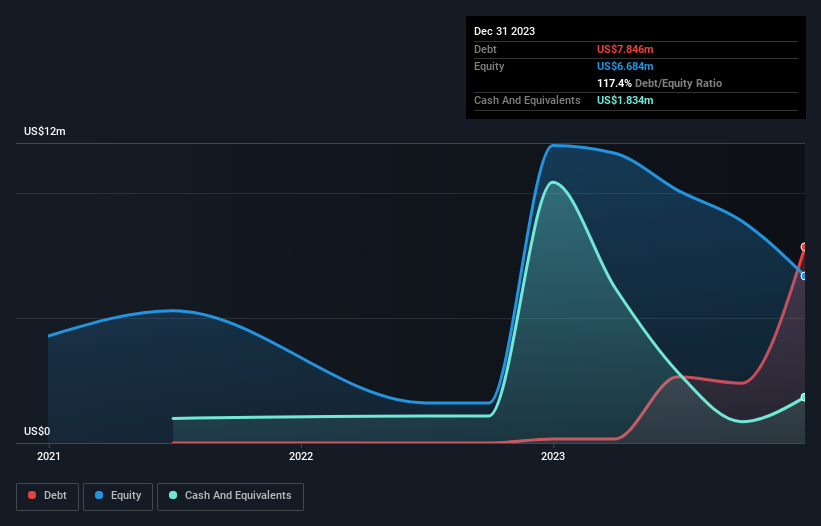
Some say volatility, rather than debt, is the best way to think about risk as an investor, but Warren Buffett famously said that 'Volatility is far from synonymous with risk.' So it might be obvious that you need to consider debt, when you think about how risky any given stock is, because too much debt can sink a company. We can see that Moolec Science SA (NASDAQ:MLEC) does use debt in its business. But the real question is whether this debt is making the company risky.
What Risk Does Debt Bring?
Debt and other liabilities become risky for a business when it cannot easily fulfill those obligations, either with free cash flow or by raising capital at an attractive price. Part and parcel of capitalism is the process of 'creative destruction' where failed businesses are mercilessly liquidated by their bankers. While that is not too common, we often do see indebted companies permanently diluting shareholders because lenders force them to raise capital at a distressed price. By replacing dilution, though, debt can be an extremely good tool for businesses that need capital to invest in growth at high rates of return. The first thing to do when considering how much debt a business uses is to look at its cash and debt together.
View our latest analysis for Moolec Science
How Much Debt Does Moolec Science Carry?
The image below, which you can click on for greater detail, shows that at December 2023 Moolec Science had debt of US$7.85m, up from US$160.0k in one year. However, it does have US$1.83m in cash offsetting this, leading to net debt of about US$6.01m.

How Healthy Is Moolec Science's Balance Sheet?
According to the last reported balance sheet, Moolec Science had liabilities of US$8.28m due within 12 months, and liabilities of US$6.36m due beyond 12 months. Offsetting this, it had US$1.83m in cash and US$1.20m in receivables that were due within 12 months. So it has liabilities totalling US$11.6m more than its cash and near-term receivables, combined.
This deficit isn't so bad because Moolec Science is worth US$52.6m, and thus could probably raise enough capital to shore up its balance sheet, if the need arose. But we definitely want to keep our eyes open to indications that its debt is bringing too much risk. When analysing debt levels, the balance sheet is the obvious place to start. But it is future earnings, more than anything, that will determine Moolec Science's ability to maintain a healthy balance sheet going forward. So if you want to see what the professionals think, you might find this free report on analyst profit forecasts to be interesting.
While it hasn't made a profit, at least Moolec Science booked its first revenue as a publicly listed company, in the last twelve months.
Caveat Emptor
Importantly, Moolec Science had an earnings before interest and tax (EBIT) loss over the last year. Indeed, it lost a very considerable US$9.5m at the EBIT level. When we look at that and recall the liabilities on its balance sheet, relative to cash, it seems unwise to us for the company to have any debt. Quite frankly we think the balance sheet is far from match-fit, although it could be improved with time. However, it doesn't help that it burned through US$13m of cash over the last year. So suffice it to say we consider the stock very risky. The balance sheet is clearly the area to focus on when you are analysing debt. However, not all investment risk resides within the balance sheet - far from it. For example, we've discovered 5 warning signs for Moolec Science (2 are significant!) that you should be aware of before investing here.
At the end of the day, it's often better to focus on companies that are free from net debt. You can access our special list of such companies (all with a track record of profit growth). It's free.
New: Manage All Your Stock Portfolios in One Place
We've created the ultimate portfolio companion for stock investors, and it's free.
• Connect an unlimited number of Portfolios and see your total in one currency
• Be alerted to new Warning Signs or Risks via email or mobile
• Track the Fair Value of your stocks
Have feedback on this article? Concerned about the content? Get in touch with us directly. Alternatively, email editorial-team (at) simplywallst.com.
This article by Simply Wall St is general in nature. We provide commentary based on historical data and analyst forecasts only using an unbiased methodology and our articles are not intended to be financial advice. It does not constitute a recommendation to buy or sell any stock, and does not take account of your objectives, or your financial situation. We aim to bring you long-term focused analysis driven by fundamental data. Note that our analysis may not factor in the latest price-sensitive company announcements or qualitative material. Simply Wall St has no position in any stocks mentioned.
About NasdaqCM:MLEC
Moolec Science
A science-based food ingredient company, focuses on developing ingredients for food, pet food, animal feed, and dietary supplements using molecular farming technology.
Slight with worrying balance sheet.
Similar Companies
Market Insights
Community Narratives



